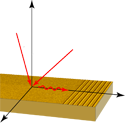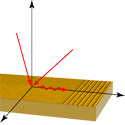Never say never to a forbidden transition
Surface plasmon polaritons (SPPs) are electromagnetic waves that are coupled to charge density oscillations at a metal/dielectric interface, and result from light or free electrons hitting the metal surface. The study of SPPs is central to the burgeoning field of plasmonics. From optoelectronics to metamaterials, imaging, and biosensing, SPPs find important applications because they are highly localized at the surface and have well-defined resonant energies.
For a given frequency of light hitting a metal surface from air, the momentum associated with the SPP in the metal will always be greater than the in-plane momentum of the light, so how can one couple to the other? Up to now, the two standard ways of exciting an SPP on a metal with light have been to either use a nonpropagating, or “evanescent,” light wave, or to use a rough or artificially corrugated surface.
Writing in Physical Review Letters, a team of researchers from ICFO in Barcelona, Spain, and the Institute of Optics at the University of Rochester in the US theoretically propose and experimentally demonstrate a new route to SPP excitation from propagating light impinging directly on a flat surface of gold. Their method to produce this “free-space excitation” involves not one but three incident photons at a time, whose momenta add to give the right balance of in-plane momentum for SPP coupling.
These SPPs have well-defined energies, momenta, and directivity. The coupling efficiency is still much too weak for this technique to be practically viable, but the rationale behind this new method could be applied towards exciting other bound modes in related systems, such as surface phonon polaritons, waveguide modes, and excitations in 2D electron gases. – Manolis Antonoyiannakis





